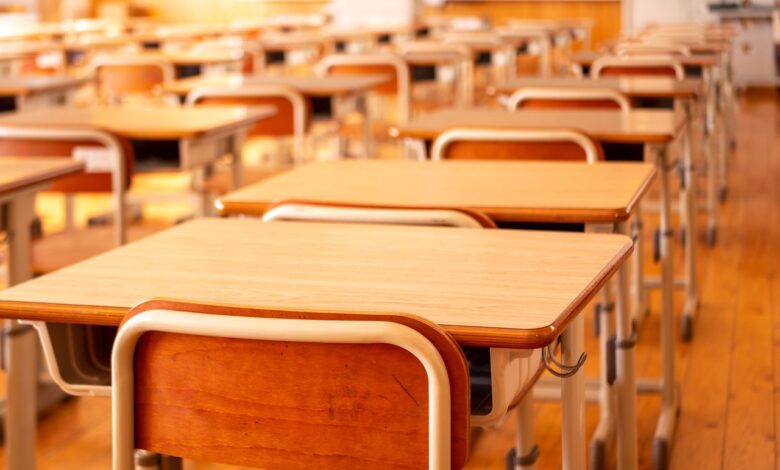The failure of open-plan classrooms
Why we need to be cautious about repeating past mistakes.

I attended a West Australian primary school, built in the mid-1960s. A relic of the push for open-plan, the six classrooms for Years One to Three were arranged in a horseshoe and separated only by orange corrugated blinds, which could be folded open to create large learning spaces. Yet, when I started school in the mid-80s, the blinds remained steadfastly closed.
Read the latest print edition of School News HERE
Apart from the end-of-year Christmas party, I recall no other time when the teachers chose to combine their classes. Yet the racket from the class next door seeped through the vinyl blinds like an unwanted guest, whether it was reciting the times table, clapping out syllables or laughter and cheering. Noise was an accepted part of every lesson.
Open-plan classrooms, once seen as a groundbreaking approach to teaching and learning in the 1960s and even earlier, have largely fallen out of favour in Australian schools. With the promise of fostering collaboration and flexibility, these open spaces—with minimal walls or physical divisions—were intended to modernise education.
The underlying idea was that traditional, rigid classroom structures were ill-suited to nurturing the skills and experiences required by 21st-century students. By removing walls, students would be able to move around, work in groups or by themselves and the teacher would be able to personalise and adapt lessons to the content as well as different learning styles of the students.
In short, it was thought the new classroom would allow for a more child-centred teaching approach.
What happened?
The reality in Australian classrooms has not lived up to this vision, with the primary issue being that of noise and distraction.
As researchers from the University of Melbourne state: “Communicating in large, noisy spaces (restaurants, shopping centres etc) is tough. Trying to piece together snippets of conversation in background noise is frustrating, exhausting and often unproductive. Why then, do we so often force children to learn in the most acoustically hostile of school environments – the open-plan classroom?” (Rance et al 2023).
Australian classrooms were not the only ones experiencing this issue. In 2010, UK researchers Shield, Greenland, and Dockrell conducted a review of all the research into noise in open-plan classrooms over the previous four decades. Students in open-plan classrooms were frequently distracted by surrounding noise, making it difficult to focus on lessons.
Teachers also reported challenges in maintaining classroom management; when students found it difficult to focus, they were more likely to engage in disruptive behaviour, while the lack of physical boundaries made it harder for teachers to control behaviour.
In addition, while open-plan classrooms were meant to facilitate collaborative learning, it has been proposed that some students felt overwhelmed and anxious in such environments. It’s also likely that students who were already struggling, neurodiverse or experiencing difficulties were going to be those disproportionately affected by noise and distractions.
A study by Imms and Byers (2017) at the University of Melbourne also suggested that teachers “had poor environmental competence,” and they did not always utilise the open space effectively for “a pedagogical advantage.” Whether it was because teachers were not adequately trained for the open-plan layout or whether it was just doomed to fail is not clear.
All in all, there was no clear evidence that open-plan classrooms enhanced academic achievement as had been hoped.
The shift to flexible spaces
Eventually policy shifted to reflect these findings, and the focus moved from open-plan classrooms to ‘flexible learning spaces.’ Walls were retained but openness and flexibility introduced with breakout rooms, moveable furniture, and quiet zones. These modifications aim to balance flexibility with the need for quieter, more focused environments conducive to learning.
A study from 2016–2019 funded by the Victorian Dept of Education found that closing partitions in open-plan classrooms doubled the rate of reading fluency growth in Grades 3–4. The researchers, Rance et al (2023), also claimed that “all mid-late primary-school students are at risk of academic delay in the open-plan setting.”
It’s alarming, then, that open-plan classrooms experienced a recent resurgence and in 2017 the New South Wales government committed to building open-plan classrooms, each for up to 120 students, at more than 100 new schools. In a scathing response, The Grattan Institute referred to open-plan classrooms as “faddish”, and the authors went on to say that governments needed to properly review the research into classroom design and ensure that the new designs support, rather than undermine, effective teaching.
In a very public and costly example of the failure of this return to open-plan classrooms, at Picton High School in Sydney, the NSW government had to commit to spending over $300,000 to build walls in open-plan classrooms that had been created just three years earlier in a 2021 renovation that cost over $100 million.
Despite the original optimism surrounding open-plan classrooms, the evidence from Australian schools suggests they have not delivered on their promises. What may have began as a bold step toward innovation in education has too often resulted in noisy, chaotic learning environments which failed to support the very students they were meant to empower. As costly redesigns and policy reversals show, educational trends must be driven by robust evidence—not fashion. Schools, educators, and policymakers must learn from these lessons and, without repeating past mistakes, commit to classroom designs that truly prioritise student learning, well-being, and equity.







